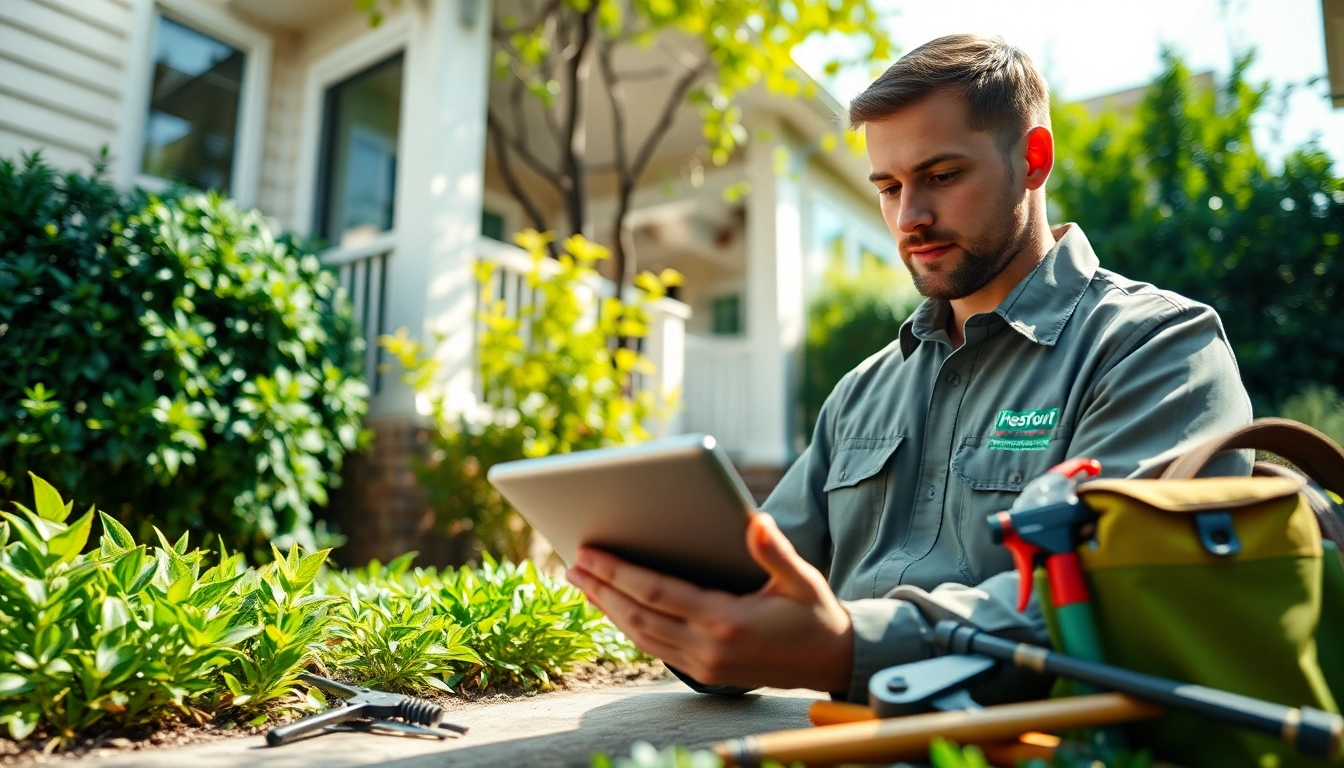Understanding Pest Management Fundamentals
What is Pest Management?
Pest management refers to the science of controlling pests that pose threats to agriculture, public health, and property. It encompasses a variety of strategies and practices designed to minimize the impact of pests while ensuring ecological balance. In essence, it is about understanding the complex interactions between pests, beneficial organisms, and their environment to manage pest populations effectively. Effective pest management not only focuses on eliminating pests but also on preventing them from becoming a problem in the first place.
The Importance of Pest Management
Effective pest management is critical for several reasons:
- Protection of Health: Some pests, such as mosquitoes and rodents, can carry diseases that pose significant health risks to humans. Effective pest management helps minimize these health threats.
- Economic Factors: Pests can cause significant damage to crops and structures, resulting in economic losses for farmers and property owners. Managing pest populations can protect these economic interests and ensure sustainability.
- Environmental Impact: Strategic pest management practices can help maintain ecological balance, protecting beneficial organisms and minimizing the use of chemical pesticides that harm the environment.
- Food Security: With the global population growing, effective pest management is essential for ensuring food security by protecting crops from pests that threaten agricultural production.
Common Types of Pests and Their Impacts
Pests can be categorized into various groups based on their behavior and what they affect:
- Agricultural Pests: Insects, rodents, and weeds that threaten crops and reduce yield. For example, aphids can devastate fruit crops by feeding on their sap.
- Structural Pests: Organisms like termites and carpenter ants that can cause extensive damage to buildings and wooden structures, leading to costly repairs.
- Health-Related Pests: Pests such as cockroaches, mosquitoes, and ticks that can transmit diseases to humans and pets.
- Stored Product Pests: Insects and rodents that infest stored food products, leading to contamination and waste.
Integrated Pest Management (IPM) Principles
Key Components of IPM
Integrated Pest Management (IPM) is a sustainable approach that combines different strategies and practices to manage pests effectively and in an environmentally responsible manner. Key components include:
- Monitoring: Regularly inspecting and identifying pest populations and their damage can provide insights into which control measures are necessary.
- Prevention: Implementing strategies to prevent pests from becoming a problem, such as improving sanitation, sealing entry points, and rotating crops.
- Control Strategies: Utilizing a combination of biological, cultural, mechanical, and chemical methods to manage pests based on monitoring and assessment.
- Evaluation: Assessing the effectiveness of pest management approaches and making adjustments as necessary to optimize results.
Benefits of Implementing IPM Strategies
Implementing IPM strategies offers multiple benefits:
- Reduced Chemical Usage: IPM emphasizes the use of less harmful pest control methods, reducing reliance on chemical pesticides and their potential negative impacts on the environment and human health.
- Cost-Effectiveness: By focusing on prevention and early detection, IPM can minimize the costs associated with pest outbreaks over time.
- Long-Term Sustainability: IPM promotes ecological balance by protecting beneficial organisms and preserving biodiversity.
- Public Awareness: Educating the community about pest management can foster a proactive approach to pest control and encourage informed decision-making.
IPM versus Traditional Pest Control
Traditional pest control often relies heavily on chemical treatments, which can lead to pest resistance and negative environmental impacts. In contrast, IPM adopts a more holistic approach:
- Approach: IPM uses a combination of methods tailored to specific pests while traditional methods often depend solely on pesticide applications.
- Risk Assessment: IPM evaluates the risks and benefits of each method, resulting in a more balanced approach to pest control.
- Long-Term Solutions: While traditional methods may provide short-term pest control, IPM focuses on long-term prevention and sustainability.
Best Practices for Home Pest Management
Preventive Measures for Homes
Preventive measures are critical in reducing the likelihood of pest infestations in the home. Here are several best practices homeowners can adopt:
- Sanitation: Keeping living spaces clean and free of food debris helps minimize attractions for pests.
- Sealing Entry Points: Inspecting and sealing cracks and openings in walls, windows, and doors can prevent pests from entering.
- Proper Food Storage: Store food in airtight containers, and dispose of waste promptly to reduce attractants.
- Landscaping: Maintain landscaping to minimize habitats for pests by keeping bushes trimmed and avoiding overgrowth.
Identifying Early Signs of Infestation
Early detection is essential for effective pest management. Familiarize yourself with the signs of common infestations:
- Droppings: Finding fecal pellets or droppings can indicate rodent activity.
- Gnaw Marks: Chewing or gnawing marks on food packages or furniture may suggest pests like mice or rats.
- Nesting Material: Evidence of nesting materials like shredded paper or fabric can signal the presence of rodents or insects.
- Visible Pests: Spotting insects, especially during their active seasons, can indicate a growing problem.
When to Call Professional Pest Management Services
While preventive measures can address many issues, sometimes professional intervention is necessary. Consider contacting a pest management service when:
- Your efforts to control pests are ineffective.
- You encounter large infestations or deal with particularly stubborn pests.
- You require specialized treatments, such as for termites or bed bugs, that necessitate expertise.
- Health concerns arise from pest activity, such as allergens or disease transmission.
Challenges in Pest Management
Common Misconceptions about Pest Control
There are several misconceptions surrounding pest management that can hinder effective practices:
- All Pests are Harmful: While many pests can be problematic, some play essential roles in ecosystems as pollinators or decomposers.
- A Single Treatment Will Solve the Problem: Effective pest management often requires a multifaceted approach and ongoing efforts.
- Organic Methods are Ineffective: Many organic pest control methods can be highly effective when properly applied and integrated with other strategies.
Environmental Concerns Related to Pesticides
The environmental impact of pesticides is a significant concern in pest management. Some of the issues include:
- Non-Target Effects: Pesticides can harm beneficial organisms, such as bees and other pollinators, as well as beneficial insects that help control pest populations.
- Soil and Water Contamination: Chemical runoff can contaminate soil and waterways, impacting plant and animal life.
- Pesticide Resistance: Over-reliance on chemical controls can lead to the development of pesticide-resistant pest populations, making pest management more challenging over time.
Dealing with Pest Resistance
Pest resistance is an ongoing struggle in pest management that requires a proactive approach. Strategies for managing resistance include:
- Rotating Control Methods: Regularly varying the types of pest control methods used can help mitigate resistance development.
- Integrating Cultural Practices: Utilizing non-chemical methods in combination with chemical treatments can help maintain effectiveness.
- Educating Stakeholders: Sharing information about pest behavior, biology, and lifecycle can help communities adopt practices that reduce resistance development.
Future Trends in Pest Management
Technological Innovations in Pest Control
Advancements in technology are paving the way for more effective pest management solutions. These innovations include:
- Smart Traps: Devices equipped with sensors can provide real-time monitoring and data collection, enabling more precise control strategies.
- Biological Control Agents: Advances in biotechnology are enabling the development of new biological control products that target specific pests while minimizing impacts on beneficial organisms.
- Data Analytics: Utilizing big data and predictive analytics can assist farmers and pest management professionals in making informed, timely decisions to manage pest threats.
Eco-Friendly Pest Management Solutions
As awareness of environmental issues grows, many are turning to eco-friendly pest management alternatives that are sustainable and less harmful. Some examples include:
- Neem Oil: Derived from the neem tree, this natural product can deter various pests without harming beneficial insects.
- Essential Oils: Various essential oils, like peppermint and lavender, can effectively repel pests due to their potent aromatic properties.
- Companion Planting: Planting specific crops together can naturally deter pests and promote healthier growth in each other.
Educating Communities on Pest Awareness
Community education is pivotal in promoting effective pest management practices. Workshops, informational campaigns, and school programs can help build awareness regarding:
- Identifying Pests: Providing resources for homeowners to recognize signs of pest activity boosts early detection efforts.
- Preventive Practices: Education on preventive measures will empower individuals to take action before problems arise.
- Pesticide Use Safety: Sharing best practices for pesticide application and safety can minimize risks to health and the environment.
- Community Involvement: Encouraging collaboration among neighbors can create a community approach to pest management that benefits all.



